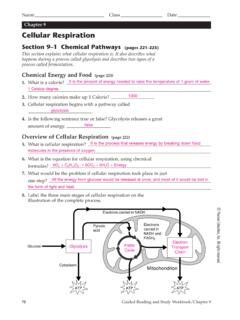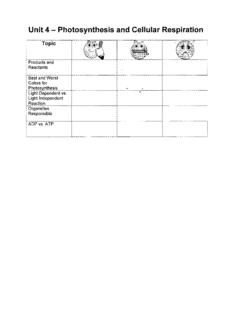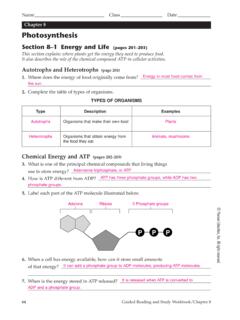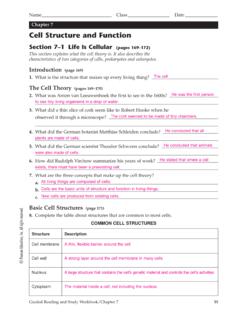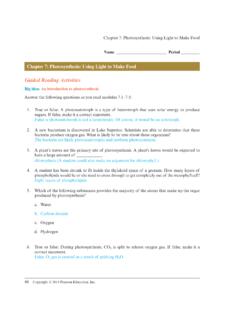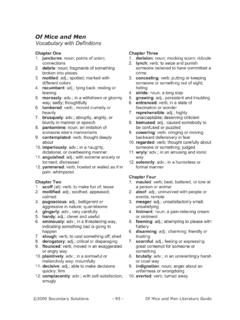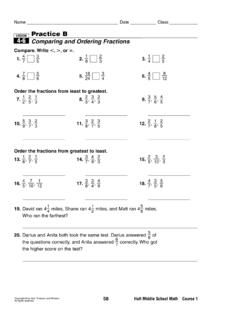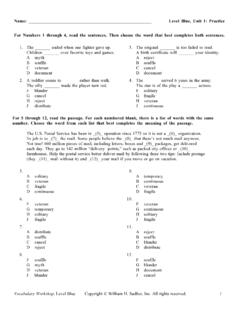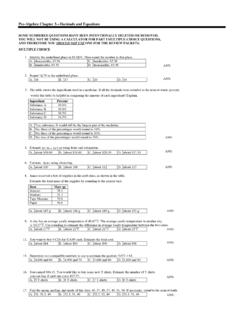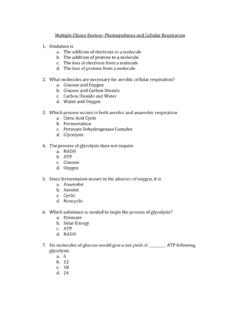Transcription of Chapter 6: How Cells Harvest Chemical Energy
1 Chapter 6: How Cells Harvest Chemical EnergyCopyright 2015 Pearson Education, Inc. 39 Name _____ Period _____# 152826 Cust: Pearson Au: Reece Pg. No. 39 Title: Active Reading Guide for Campbell Biology: Concepts & Connections, 8eC / M / Y / KShort / NormalDESIGN SERVICES OFS4-CARLISLEP ublishing ServicesChapter 6: How Cells Harvest Chemical EnergyGuided Reading ActivitiesBig idea: cellular respiration : Aerobic harvesting of energyAnswer the following questions as you read modules : 1. Plants release what gaseous by-product as a result of photosynthesis ? a. O2 b. CO2 c. H2O d. Solar Energy 2. _____ is always lost during photosynthesis and cellular respiration . 3. Students frequently have the misconception that plant Cells don t perform cellular respiration .
2 Briefly explain the basis of this misconception. 4. True or false: Blood traveling from your leg muscles to the lungs would be high in oxygen. If false, make it a correct statement. 5. How are photosynthesis and cellular respiration linked on a molecular level? 6. Any substance that inhibits the transportation of oxygen from the lungs affects _____. a. photosynthesis b. cellular respiration c. chloroplasts d. none of the aboveEnergy This misconception arises because plant Cells perform photosynthesis , which creates the as-sumption that plant Cells do not perform cellular respiration . False, it would be low in oxygen. They are linked in that the products of one are the reactants of the 3929/10/14 10:34 AMChapter 6: How Cells Harvest Chemical Energy # 152826 Cust: Pearson Au: Reece Pg.
3 No. 40 Title: Active Reading Guide for Campbell Biology: Concepts & Connections, 8eC / M / Y / KShort / NormalDESIGN SERVICES OFS4-CARLISLEP ublishing Services40 Copyright 2015 Pearson Education, Inc. 7. The overall Chemical equation for cellular respiration is: C6H12O6 1 6O2 6CO2 1 6H2O Briefly explain why the equation has multiple arrows. 8. CO2 is a gaseous by-product of cellular respiration that you exhale with each breath. Briefly explain where the CO2 comes from. 9. Fill in the following table regarding the inputs and outputs of cellular + C6H12O6CO2 + H2O 10. You are taking a road trip from Chicago to Denver. The trip is going to take roughly 15 hours. At the start of your trip, you get a 96-oz Mega Gulp from 11-seven of Mountain Mist.
4 This beverage will have roughly 1,360 kcal. How long into your trip will you have burned the calo-ries from this drink? Refer to Figure in your textbook on page 91. 11. The formation of NaCl (table salt) involves an atom of Na giving an electron to an atom of Cl. a. This would be considered a redox reaction. b. Na got oxidized. c. Cl got reduced. d. All of the above are true statements regarding the formation of NaCl. 12. Briefly explain why a teeter-totter is a good analogy for describing how reductions and oxida-tions always go together. 13. True or false: The transfer of H atoms from glucose to oxygen does not represent redox reactions. If false, make it a correct idea: Stages of cellular respirationAnswer the following questions as you read modules : 1.
5 Which of the following is the correct order of the main stages of cellular respiration ? a. Citric acid cycle, glycolysis, oxidative phosphorylation The arrows represent the fact that cellular respiration consists of multiple Chemical reactions. The CO2 comes from the organic molecules (food) that you consume and is a by-product of cellular respiration . It would actually take longer than your trip, a bit over 22 hours. It s a good analogy because, for every reduction, there is an oxidation, and vice versa. This is similar to a teeter-totter: When one side goes up, the other has to go down. False, it does represent redox reactions, as oxygen gas is 4029/10/14 10:34 AMChapter 6: How Cells Harvest Chemical Energy # 152826 Cust: Pearson Au: Reece Pg.
6 No. 41 Title: Active Reading Guide for Campbell Biology: Concepts & Connections, 8eC / M / Y / KShort / NormalDESIGN SERVICES OFS4-CARLISLEP ublishing ServicesCopyright 2015 Pearson Education, Inc. 41 b. Glycolysis, citric acid cycle, oxidative phosphorylation c. Citric acid cycle, oxidative phosphorylation, glycolysis d. Oxidative phosphorylation, glycolysis, citric acid cycle 2. Match the following stages of cellular respiration with the correct characteristics. Some stages may have more than one characteristic or share characteristics. For glycolysis, put A; for citric acid cycle, put B; and for oxidative phosphorylation, put in the cytosol: _____Occurs in the mitochondria: _____Involves the splitting of glucose: _____Produces molecules of NADH: _____Produces ATP: _____Produces CO2: _____FADH2 shuttles electrons to the electron transport chain: _____Occurs in a plant cell: _____Occurs in an animal cell: _____Uses the potential Energy of a H+ gradient: _____Produces molecules of FADH2: _____Substrate-level phosphorylation occurs: _____ 3.
7 _____ uses the Energy found within a proton gradient to drive the syn-thesis of ATP. 4. True or false: A substance that makes the inner mitochondrial membrane leaky to H1 (H1 would be able to leak across the membrane at points other than ATP synthase) increases ATP production in mitochondria. If false, make it a correct statement. False, it would decrease ATP production as ATP synthase efficiency would be , CAA, BA, B, CBA, B, CA, B, CCBA, BCATP 4129/10/14 10:34 AMChapter 6: How Cells Harvest Chemical Energy # 152826 Cust: Pearson Au: Reece Pg. No. 42 Title: Active Reading Guide for Campbell Biology: Concepts & Connections, 8eC / M / Y / KShort / NormalDESIGN SERVICES OFS4-CARLISLEP ublishing Services42 Copyright 2015 Pearson Education, Inc.
8 5. The driving force behind oxidative phosphorylation is _____. a. oxygen b. carbon dioxide c. NADH d. H2O 6. True or false: Brown fat contains mitochondria. If false, make it a correct statement. 7. What initial observation led scientists to hypothesize that brown fat may be activated by cold temperatures?Big idea: Fermentation: Anaerobic harvesting of energyAnswer the following questions as you read modules : 1. _____ generates fewer molecules of ATP because it contributes its electrons further along the electron transport chain. 2. The only portion of cellular respiration that is cyclic is _____. a. glycolysis b. the electron transport chain c. the citric acid cycle d. the oxidation of pyruvate 3.
9 In lactic acid fermentation, _____ becomes the target of reduction by NADH. a. pyruvate b. lactate c. glucose d. ATP True Brown fat tissue was found at higher levels when the scans were taken during cold 4229/10/14 10:34 AMChapter 6: How Cells Harvest Chemical Energy # 152826 Cust: Pearson Au: Reece Pg. No. 43 Title: Active Reading Guide for Campbell Biology: Concepts & Connections, 8eC / M / Y / KShort / NormalDESIGN SERVICES OFS4-CARLISLEP ublishing ServicesCopyright 2015 Pearson Education, Inc. 43 4. Fermentation is essentially glycolysis because glycolysis does not require _____ to function. 5. If you opened a wine vat, would the yeast inside continue to perform alcoholic fermentation?
10 Briefly explain your answer with some details about what would happen. 6. List two sources of evidence that indicate glycolysis is extremely idea: Fermentation: Connections between metabolic pathwaysAnswer the following questions as you read modules : 1. What must proteins be broken down into before they can be burned as Energy ? Refer to Figure on page 102 in your textbook. 2. Fats are hydrophobic and carbohydrates are hydrophilic. Use this information to explain why humans store the majority of their excess Energy as fat and not carbohydrates. 3. True or false: Glycolysis and the citric acid cycle both function as metabolic interchanges where the products of their Chemical reactions can also be used for biosynthesis.
